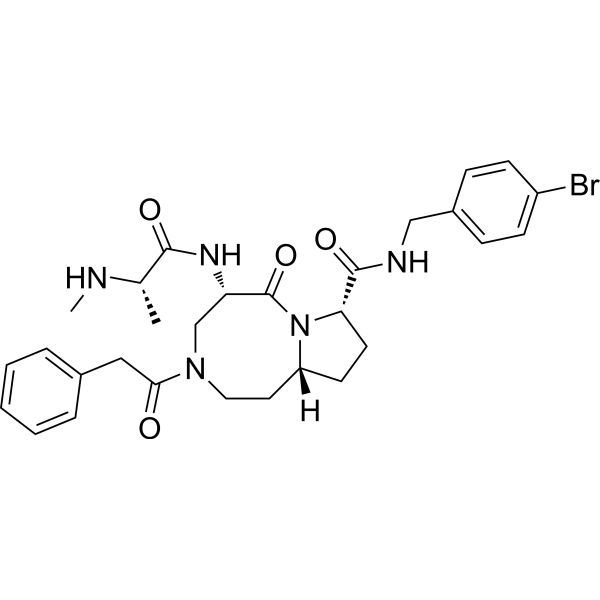Physicochemical Properties
| Molecular Formula | C29H36BRN5O4 |
| Exact Mass | 597.195 |
| CAS # | 1562375-46-5 |
| Related CAS # | 1562375-46-5 |
| PubChem CID | 155904417 |
| Appearance | White to light yellow solid |
| LogP | 2.4 |
| Hydrogen Bond Donor Count | 3 |
| Hydrogen Bond Acceptor Count | 5 |
| Rotatable Bond Count | 8 |
| Heavy Atom Count | 39 |
| Complexity | 874 |
| Defined Atom Stereocenter Count | 4 |
| SMILES | C[C@@H](C(=O)N[C@H]1CN(CC[C@H]2CC[C@H](N2C1=O)C(=O)NCC3=CC=C(C=C3)Br)C(=O)CC4=CC=CC=C4)NC |
| InChi Key | SOTHWYAWZKSXSA-CTZQYXLCSA-N |
| InChi Code | InChI=1S/C29H36BrN5O4/c1-19(31-2)27(37)33-24-18-34(26(36)16-20-6-4-3-5-7-20)15-14-23-12-13-25(35(23)29(24)39)28(38)32-17-21-8-10-22(30)11-9-21/h3-11,19,23-25,31H,12-18H2,1-2H3,(H,32,38)(H,33,37)/t19-,23+,24-,25-/m0/s1 |
| Chemical Name | (5S,8S,10aR)-N-[(4-bromophenyl)methyl]-5-[[(2S)-2-(methylamino)propanoyl]amino]-6-oxo-3-(2-phenylacetyl)-1,2,4,5,8,9,10,10a-octahydropyrrolo[1,2-a][1,5]diazocine-8-carboxamide |
| Synonyms | SM-1295 |
| HS Tariff Code | 2934.99.9001 |
| Storage |
Powder-20°C 3 years 4°C 2 years In solvent -80°C 6 months -20°C 1 month Note: Please store this product in a sealed and protected environment, avoid exposure to moisture. |
| Shipping Condition | Room temperature (This product is stable at ambient temperature for a few days during ordinary shipping and time spent in Customs) |
Biological Activity
| Targets | XIAP-BIR3 (Kd = 3077 nM); c-IAP1-BIR3 (Kd = 3.2 nM); c-IAP2-BIR3 (Kd = 9.5 nM) |
| ln Vitro | SM-1295 (compound 5) binds to both cIAP1 and cIAP2 proteins with Ki values of <10 nM and displays a selectivity of >900-fold for cIAP1 over XIAP[1]. In MDA-MB-231, SM-1295 (compound 5) displays an IC50 of 46 nM[1]. |
| References |
[1]. Potent and Selective Small-Molecule Inhibitors of cIAP1/2 Proteins Reveal That the Binding of Smac Mimetics to XIAP BIR3 Is Not Required for Their Effective Induction of Cell Death in Tumor Cells. ACS Chem Biol. 2014 Apr 18;9(4):994-1002. [2]. Inhibitor of Apoptosis Protein (IAP) Antagonists in Anticancer Agent Discovery: Current Status and Perspectives. J Med Chem. 2019 Jun 27;62(12):5750-5772. |
Solubility Data
| Solubility (In Vitro) | DMSO: ~310 mg/mL (~517.9 mM) |
| Solubility (In Vivo) |
Solubility in Formulation 1: ≥ 7.75 mg/mL (12.95 mM) (saturation unknown) in 10% DMSO + 40% PEG300 + 5% Tween80 + 45% Saline (add these co-solvents sequentially from left to right, and one by one), clear solution. For example, if 1 mL of working solution is to be prepared, you can add 100 μL of 77.5 mg/mL clear DMSO stock solution to 400 μL PEG300 and mix evenly; then add 50 μL Tween-80 to the above solution and mix evenly; then add 450 μL normal saline to adjust the volume to 1 mL. Preparation of saline: Dissolve 0.9 g of sodium chloride in 100 mL ddH₂ O to obtain a clear solution. Solubility in Formulation 2: ≥ 7.75 mg/mL (12.95 mM) (saturation unknown) in 10% DMSO + 90% (20% SBE-β-CD in Saline) (add these co-solvents sequentially from left to right, and one by one), clear solution. For example, if 1 mL of working solution is to be prepared, you can add 100 μL of 77.5 mg/mL clear DMSO stock solution to 900 μL of 20% SBE-β-CD physiological saline solution and mix evenly. Preparation of 20% SBE-β-CD in Saline (4°C,1 week): Dissolve 2 g SBE-β-CD in 10 mL saline to obtain a clear solution. (Please use freshly prepared in vivo formulations for optimal results.) |
